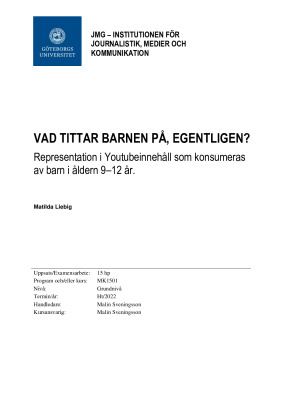VAD TITTAR BARNEN PÅ, EGENTLIGEN?
Representation i Youtubeinnehåll som konsumeras
av barn i åldern 9–12 år
Executive summary
Different media outlets have a big role in shaping our perception of reality, perhaps even more so for children. They have fewer reference points with real life than us adult, what they see in various channels is more or less all they know of the outside world. Therefore, when it
comes to equality between the sexes and other differences – such as class, sexuality, and ethnicity – media can be considered to play an important part in driving equality forward, but also potentially slowing it down.
The purpose of this study is to examine representation in the content on the digital platform Youtube consumed by children aged 9 to 12 in Sweden. Three popular Swedish Youtube channels in the age group have been selected, and one video from each channel have been
analysed using the ethnographic content analysis (ECA) according to Altheide and Schneider (2013). The study includes theories of representation, gender, and intersectionality, and is focused on different visible norms and stereotypes in the content, both reinforced and opposed. The study ends with a discussion of what meaning making processes that possibly could occur for children consuming these particular Youtube channels.
The questions that this study set out to answer are who is portrayed in the videos, how much space are they allowed, how are they portrayed in regard to different norms and stereotypes correlated to gender and ethnicity, and lastly what relationships are observed between the
individuals in the videos and what sort of power dynamics exist within these relations?
The results show that the content consist mainly of white people and that the majority of all portrayed individuals are men. This goes in line with the current statistical representation in
traditional media as well. It is also more common with upholding of various norms than opposing them, and some stereotypes can be seen as prominent. The hierarchy which places the man before the woman can also be considered salient, this being visible in discourse and
areas of responsibility. Overall, the content can be seen as reproducing a certain way of being and living, and therefor create a perception of right and wrong, for both women and men.

